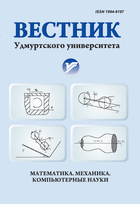Все выпуски
- 2025 Том 35
- 2024 Том 34
- 2023 Том 33
- 2022 Том 32
- 2021 Том 31
- 2020 Том 30
- 2019 Том 29
- 2018 Том 28
- 2017 Том 27
- 2016 Том 26
- 2015 Том 25
- 2014
- 2013
- 2012
- 2011
- 2010
- 2009
- 2008
-
О типе мероморфной функции конечного порядка, с. 212-224Пусть $f(z)$ — мероморфная функция на комплексной плоскости конечного порядка $\rho>0$, $\rho(r)$ — уточненный порядок в смысле Бутру такой, что $0<\alpha=\liminf\limits_{r\to\infty}\rho(r)\leqslant\limsup\limits_{r\to\infty}\rho(r)=\rho<\infty$. Если $[\alpha]<\alpha\leqslant\rho<[\alpha]+1$, то типы $T(r,f)$ и $|N|(r,f)$ относительно $\rho(r)$ совпадают. Если между $\alpha$ и $\rho$ есть целые числа, то полученный критерий формулируется в терминах верхней плотности нулей и полюсов функции $f$ и их аргументной симметрии.
Let $f(z)$ be a meromorphic function on the complex plane of finite order $\rho>0$. Let $\rho(r)$ be a proximate order in the sense of Boutroux such that $\limsup\limits_{r\to\infty}\rho(r)=\rho$, $\liminf\limits_{r\to\infty}\rho(r)=\alpha>0$. If $[\alpha]<\alpha\leqslant\rho<[\alpha]+1$ then the types of $T(r,f)$ and $|N|(r,f)$ coincide with respect to $\rho(r)$. If there are integers between $\alpha$ and $\rho$, then the resulting criterion is formulated in terms of the upper density of zeros and poles of the function $f$ and their argument symmetry.
-
В данной работе методом вложения строится классификация феноменологически симметричных геометрий двух множеств ранга $(n+1,m)$ при $n\geqslant2$ и $m\geqslant 3$. Суть этого метода состоит в нахождении метрических функций феноменологически симметричных геометрий двух множеств высокого ранга по известной феноменологически симметричной геометрии двух множеств ранга на единицу ниже. Так, по метрической функции феноменологически симметричной геометрии двух множеств ранга $(n+1,n)$ находится метрическая функция феноменологически симметричной геометрии двух множеств ранга $(n+1,n+1)$, по которой потом находится метрическая функция геометрии ранга $(n+1,n+2)$. Затем доказывается, что вложение феноменологически симметричной геометрии двух множеств ранга $(n+1,n+2)$ в феноменологически симметричную геометрию ранга $(n+1,n+3)$ отсутствует. С учетом симметрии метрической функции относительно первого и второго аргументов в конце работы методом математической индукции завершается классификация. Для решения поставленной задачи записываются специальные функциональные уравнения, которые сводятся к хорошо известным дифференциальным уравнениям.
феноменологически симметричная геометрия двух множеств, метрическая функция, дифференциальное уравнениеIn this paper, a classification of phenomenologically symmetric geometries of two sets of rank $(n+1,m)$ with $n\geqslant 2$ and $m\geqslant 3$ is constructed by the method of embedding. The essence of this method is to find the metric functions of phenomenologically symmetric geometries of two high-rank sets by the known phenomenologically symmetric geometries of two sets of a rank which is lower by unity. By the known metric function of the phenomenologically symmetric geometry of two sets of rank $(n+1,n)$, we find the metric function of the phenomenologically symmetric geometry of rank $(n+1,n+1)$, on the basis of which we find later the metric function of the phenomenologically symmetric geometry of rank $(n+1,n+2)$. Then we prove that there is no embedding of the phenomenologically symmetric geometry of two sets of rank $(n+1,n+2)$ in the phenomenologically symmetric geometry of two sets of rank $(n+1,n+3)$. At the end of the paper, we complete the classification using the mathematical induction method and taking account of the symmetry of a metric function with respect to the first and the second argument. To solve the problem, we write special functional equations, which reduce to the well-known differential equations.
Журнал индексируется в Web of Science (Emerging Sources Citation Index)
Журнал входит в базы данных zbMATH, MathSciNet
Журнал включен в базу данных Russian Science Citation Index (RSCI) на платформе Web of Science
Журнал входит в систему Российского индекса научного цитирования.
Журнал включен в перечень ВАК.
Электронная версия журнала на Общероссийском математическом портале Math-Net.Ru.




